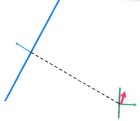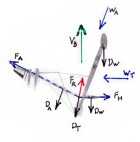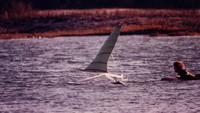High-Speed Sailing
| Vessel Name: | Sailien |
| Vessel Make/Model: | Experimental/custom |
28 September 2013
The America’s Cup
I watched, with interest, the videos of the 34th America’s Cup. At last we have fast sailboats engaged in a competition that is fun to watch. The virtual images (such as course boundaries, distance grid lines, separation between boats, etc.) overlaid on the real images really helps to keep the race [...]
31 August 2013
100 Knots for Hydroptere?
The latest news from Hydroptere is that they have plans for a 100 knot sailboat. This was posted on 26 Aug 2013, so look for that date at this address. http://hydroptere.com/en/the-news/last-news/
17 November 2012
Aptly named Sailrocket, blasts off!
While yet to be ratified, Sailrocket posted an average speed over 500 meters of 59 knots. I will not be surprised if they increase their record into the 60 knot range during this record attempt.
02 January 2012
More drag for VSR2?
I want to start by pointing out that the whole VSR2 team has done a stellar job and has demonstrated conclusively that the forces that drive a sailboat can be aligned for roll stability without using ballast and without using any down-force. (Trifoiler achieved roll stability by using down-force, but [...]
18 December 2011
My analysis of Sailrocket
I copied a diagram of VSR2 (wing doesn’t show well) and added in the major force arrows that apply. Be aware that these arrows are not correct in terms of scale (length) and some of their locations are guesses, however I believe I’m correct enough for us to learn something about what VSR2 has been [...]
23 October 2011
60 is within reach, what’s next?
I have been watching Sailrocket’s progress with great interest and there’s no question they have a winner. I fully expect to see them reach 60kt in the near future. Sailrocket has now demonstrated what I first learned with my models and again with my full-sized prototypes, that if you get the forces [...]
Fundamentals
From what I've seen so far, every major problem, crash, etc. has been a problem with fundamentals. Now some might say that a wing (Sailrocket, Innovation, etc.) or hydrofoils (Hydroptere, Wotrocket, etc.) are exotic, but you need an airfoil (wing or sail) and a hydrofoil (keel, centerboard etc.) just to have a sailboat that can sail at some angle to the wind. I will class wings and hydrofoils as being fundamental in their function; however we could class their shape as being exotic.
The fundamentals that have to be accounted for are pitch, roll and yaw (which I discussed in a post of that name on 14 June 08). The forces that act on a sailboat have to be balanced in order to maintain control. The greater the velocity of the wind or the craft, the more critical this balance becomes. Anytime there is an imbalance of these forces, the craft will deviate from its intended motion. If the imbalance is great enough, control will be lost. It doesn't matter how exotic the shape of the airfoil or hydrofoil may be; the problem is how to maintain a balance of forces at all times.
I definitely classify Wotrocket's super-cavitating hydrofoil shape as being exotic, but the craft flipped because control of the force balance was lost. Actually, from their statements, they were unable to de-power or steer, indicating the problem was not actually a sailing design problem but a mechanical design problem of the controls.
While we don't actually have a description of Hydroptere's crash, I'm assuming that the description I posted is what happened (roll to port, then pitch forward). No matter how exotic we might consider its hydrofoils to be, control of the fundamentals was lost and the craft flipped. Essentially, their means of control was inadequate to maintain proper force balance in the gust that accelerated them to 61 knots.
Sailrocket's flip was due to a loss of pitch control. That the cross-arm airfoil was designed to "fly" the lee pod to reduce drag could be called exotic; the fact that too much lift was generated, flipping the craft, is a fundamental pitch control problem.
While all the craft we are watching chase the record are quite exotic in appearance; their limits in speed are still being hindered by the fundamentals. Once a designer gets the fundamentals fully under control, craft efficiency (exotics), the true wind velocity, and possibly surface conditions, will dictate top speed.
There is one area that we really don't want the forces to balance, that is: forward acceleration. However, when the driving force is equaled by the total drag, the craft is at its top speed for the existing true wind. Only by an increase in efficiency, will the craft go faster for that true wind velocity. At this time Macquarie Innovation is the efficiency king, per the true wind speed compared to boat speed numbers they posted.
Once the fundamentals are fully conquered, I expect to see a significant increase in boat speed.
Bob
About & Links
- Bob's Surfing Blog
- Bob's Website
- Greenbird (Windjet)
- l'Hydroptere
- Le Projet Dared
- Macquarie Speed Sailing Team
- Monofoil Sailing
- Mountain Goat STOL
- Mr Smith's Amazing Sailboats
- Patent Office (Search)
- Radboat
- Sailien Prototypes (early), Delta, etc.
- Sailien Video
- Sailien Website
- The Basics of Surfboard Design
- The Basics of Surfboard Design en Espanol
- The Swedish Speed-Sailing Challenge
- Trifoiler
- Vestas Sailrocket
- Windjet Project
- WSSRC


